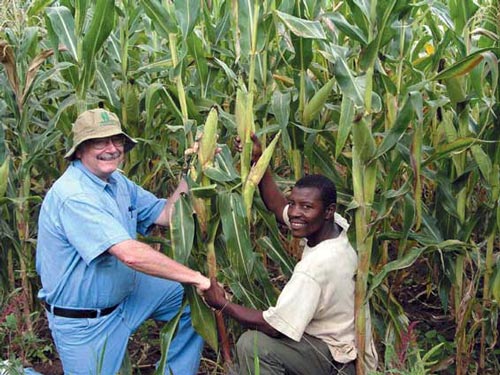 After a successful 37-year career and living on 4 continents, most people welcome retirement with open arms. Wayne Haag is not most people. Mission-oriented since childhood, the only question is, where will he end up next?
After a successful 37-year career and living on 4 continents, most people welcome retirement with open arms. Wayne Haag is not most people. Mission-oriented since childhood, the only question is, where will he end up next?
Assigned to CIMMYT as a Rockefeller Foundation Fellow in 1973, Haag first worked in Mexico alongside Dr Ernest Sprague and the maize team, and later as a maize specialist representing the center in Egypt, Turkey, the Middle East, and the South American region, where he continued until leaving CIMMYT’s employ in 1989. Since that time, and through the end of 2009, he worked with the Sasakawa Global 2000 program, an effort begun by Ryoichi Sasakawa and enlisting the participation and leadership of US President Jimmy Carter and Nobel Peace Laureate Dr. Norman Borlaug, to offer sub-Saharan African farmers technology options for improving their productivity and food security.
During that tenure, in addition to other responsibilities, Haag focused on and promoted quality protein maize (QPM) in 12 project countries. Recently retired from SG 2000, Haag shows no sign of slowing down.
“I’m not ready for full retirement,” says Haag. “I hope to continue to be involved in international agriculture development. What form that will take? I’m not sure quite yet, but am in the process of exploring possibilities.”
Haag served in the US Peace Corps’ first project in Guatemala during 1963-64, an agricultural extension project, at the decree of President John F. Kennedy. Inspired by that experience, he later pursued studies in agricultural development and science at Michigan State University and Pennsylvania State University.
Throughout his long travels and career, Haag has preserved close linkages with CIMMYT friends and partners. “Every national maize program I worked with had a very strong partnership with CIMMYT,” he says. “Even though I may have not been employed by CIMMYT for many years, it is almost as if I have never left.”
This week Haag and his wife Maria were in Mexico to touch base with long-time coworker, friend, and retired CIMMYT Distinguished Scientist, Surinder K. Vasal. Vasal and retired CIMMYT cereal chemist Evangelina Villegas shared the 2000 World Food Prize for their work in the 1970-80s to develop QPM, seen as a breakthrough in maize breeding by Haag and maize scientists around the world. During a visit to El Batán, Haag said he is certain the center’s work with QPM is not done.
“It is my sincere hope that CIMMYT will strengthen its activities in quality protein maize. This can be done by increasing the numbers of maize breeders and concentrating on germplasm maintenance, improvement, and development,” he says. Haag believes CIMMYT can produce QPM open-pollinated varieties and hybrids that also contains enhanced levels of methionine, provitamin A, iron, and zinc. “This seed would revolutionize global maize production and add tremendous value to the crop both in terms of human and animal nutrition,” he says.

